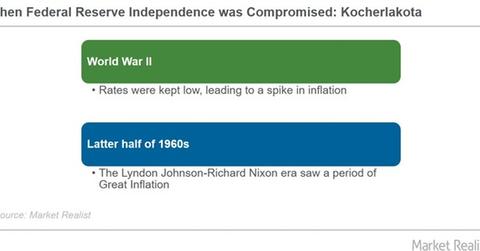Narayana Kocherlakota on Trump and the Federal Reserve
Narayana Kocherlakota, 12th president of the Federal Reserve Bank of Minneapolis, said central banks have been able to control inflation better when left alone by the government.
Nov. 18 2016, Published 10:21 a.m. ET

Trouble for the Federal Reserve?
Narayana Kocherlakota was the 12th president of the Federal Reserve Bank of Minneapolis from 2009 to 2015. In a November 15, 2016, column in Bloomberg View, he expressed his thoughts on the impact of Donald Trump on the Federal Reserve. He was quite bearish on the Trump presidency, titling his article “How Trump Could Spell Trouble for the Fed.”
He said that according to research, the central banks have been able to control inflation better when left alone by the government. On the interference of the government, he said that “historically, the executive branch has presented the greatest threat to the independence of the U.S. Federal Reserve.”
Two major failures
Kocherlakota cited two instances when the independence of the Federal Reserve was compromised since its founding in 1913.
The first instance was during and after World War II when the Fed held rates down to allow the government to borrow cheaply, thus leading to a surge in inflation.
The second was in the latter half of the 1960s, when “Presidents Lyndon Johnson and Richard Nixon put (largely covert) pressure on Fed chairs William McChesney Martin and Arthur Burns to provide monetary stimulus to keep unemployment low and generate more popular support for their administrations.” This led to what we call the Great Inflation.
What can Trump do?
Kocherlakota said that Trump can appoint four of the seven members of the Fed’s Board of Governors by 2018, including the chair and the vice chair. If these four appointees agree with Trump’s economic growth agenda, they could position monetary policy to be supportive of such an agenda, even at the cost of high inflation.
Kocherlakota added, “There is absolutely nothing in U.S. law preventing Trump from violating the Fed’s independence, a post-1979 development that rests largely on the restraint of the president.”
These are interesting but unnerving times for both equity (DIA) (SPLV) (IWF) and bond investors. A rise in interest rates could hurt bonds (BSV), although a lot of it has already been priced in. It could also hurt utilities (XLU), which are considered bond proxies.
It remains to be seen if Trump will leave the Fed to itself. But his aggressive stance on monetary policy and other issues during his campaign doesn’t seem to support that.
